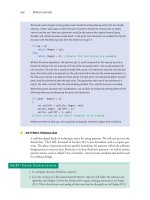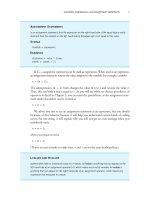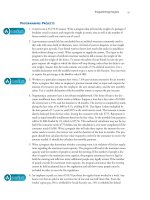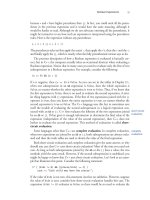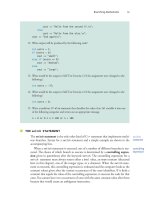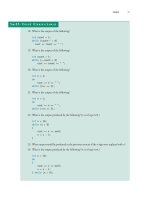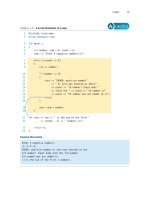Absolute C++ (4th Edition) part 5 potx
Bạn đang xem bản rút gọn của tài liệu. Xem và tải ngay bản đầy đủ của tài liệu tại đây (456.18 KB, 10 trang )
Programming Projects 41
PROGRAMMING PROJECTS
1. A metric ton is 35,273.92 ounces. Write a program that will read the weight of a package of
breakfast cereal in ounces and output the weight in metric tons as well as the number of
boxes needed to yield one metric ton of cereal.
2. A government research lab has concluded that an artificial sweetener commonly used in
diet soda will cause death in laboratory mice. A friend of yours is desperate to lose weight
but cannot give up soda. Your friend wants to know how much diet soda it is possible to
drink without dying as a result. Write a program to supply the answer. The input to the
program is the amount of artificial sweetener needed to kill a mouse, the weight of the
mouse, and the weight of the dieter. To ensure the safety of your friend, be sure the pro-
gram requests the weight at which the dieter will stop dieting, rather than the dieter’s cur-
rent weight. Assume that diet soda contains one-tenth of 1% artificial sweetener. Use a
variable declaration with the modifier
const to give a name to this fraction. You may want
to express the percentage as the
double value 0.001.
3. Workers at a particular company have won a 7.6% pay increase retroactive for six months.
Write a program that takes an employee’s previous annual salary as input and outputs the
amount of retroactive pay due the employee, the new annual salary, and the new monthly
salary. Use a variable declaration with the modifier
const to express the pay increase.
4. Negotiating a consumer loan is not always straightforward. One form of loan is the dis-
count installment loan, which works as follows. Suppose a loan has a face value of $1,000,
the interest rate is 15%, and the duration is 18 months. The interest is computed by multi-
plying the face value of $1,000 by 0.15, yielding $150. That figure is then multiplied by
the loan period of 1.5 years to yield $225 as the total interest owed. That amount is imme-
diately deducted from the face value, leaving the consumer with only $775. Repayment is
made in equal monthly installments based on the face value. So the monthly loan payment
will be $1,000 divided by 18, which is $55.56. This method of calculation may not be too
bad if the consumer needs $775 dollars, but the calculation is a bit more complicated if the
consumer needs $1,000. Write a program that will take three inputs: the amount the con-
sumer needs to receive, the interest rate, and the duration of the loan in months. The pro-
gram should then calculate the face value required in order for the consumer to receive the
amount needed. It should also calculate the monthly payment.
5. Write a program that determines whether a meeting room is in violation of fire law regula-
tions regarding the maximum room capacity. The program will read in the maximum room
capacity and the number of people to attend the meeting. If the number of people is less
than or equal to the maximum room capacity, the program announces that it is legal to
hold the meeting and tells how many additional people may legally attend. If the number
of people exceeds the maximum room capacity, the program announces that the meeting
cannot be held as planned due to fire regulations and tells how many people must be
excluded in order to meet the fire regulations.
6. An employee is paid at a rate of $16.78 per hour for regular hours worked in a week. Any
hours over that are paid at the overtime rate of one and one-half times that. From the
worker’s gross pay, 6% is withheld for Social Security tax, 14% is withheld for federal
01_CH01.fm Page 41 Wednesday, August 20, 2003 2:21 PM
42 C++ Basics
income tax, 5% is withheld for state income tax, and $10 per week is withheld for union
dues. If the worker has three or more dependents, then an additional $35 is withheld to
cover the extra cost of health insurance beyond what the employer pays. Write a program
that will read in the number of hours worked in a week and the number of dependents as
input and that will then output the worker’s gross pay, each withholding amount, and the
net take-home pay for the week.
01_CH01.fm Page 42 Wednesday, August 20, 2003 2:21 PM
For additional online
Programming Projects,
click the CodeMate
icons below.
1.7
2
Flow of Control
2.1 BOOLEAN EXPRESSIONS 44
Building Boolean Expressions 44
Pitfall: Strings of Inequalities 45
Evaluating Boolean Expressions 46
Precedence Rules 48
Pitfall: Integer Values Can Be Used as Boolean Values 52
2.2 BRANCHING MECHANISMS 54
if-else
Statements 54
Compound Statements 56
Pitfall: Using
= in Place of
==
57
Omitting the
else
58
Nested Statements 59
Multiway
if-else
Statement 59
The
switch
Statement 61
Pitfall: Forgetting a
break
in a
switch
Statement 63
Tip: Use
switch
Statements for Menus 63
Enumeration Types 64
The Conditional Operator 64
2.3 LOOPS 66
The
while
and
do-while
Statements 66
Increment and Decrement Operators Revisited 69
The Comma Operator 72
The
for
Statement 73
Tip: Repeat-N-Times Loops 76
Pitfall: Extra Semicolon in a
for
Statement 76
Pitfall: Infinite Loops 77
The
break
and
continue
Statements 80
Nested Loops 83
CHAPTER SUMMARY 83
ANSWERS TO SELF-TEST EXERCISES 84
PROGRAMMING PROJECTS 89
2
Flow of Control
“Would you tell me, please, which way I ought to go from here?”
“That depends a good deal on where you want to get to,” said
the Cat.
Lewis Carroll,
Alice in Wonderland
INTRODUCTION
As in most programming languages, C++ handles flow of control with branch-
ing and looping statements. C++ branching and looping statements are similar
to branching and looping statements in other languages. They are the same as
in the C language and very similar to what they are in the Java programming
language. Exception handling is also a way to handle flow of control. Excep-
tion handling is covered in Chapter 18.
Boolean Expressions
He who would distinguish the true from the false must have an
adequate idea of what is true and false.
Benedict Spinoza,
Ethics
Most branching statements are controlled by Boolean expressions. A
Boolean
expression
is any expression that is either true or false. The simplest form for
a Boolean expression consists of two expressions, such as numbers or variables,
that are compared with one of the comparison operators shown in Display
2.1. Notice that some of the operators are spelled with two symbols, for exam-
ple,
==
,
!=
,
<=
,
>=
. Be sure to notice that you use a double equal
==
for the
equal sign and that you use the two symbols
!=
for not equal. Such two-
symbol operators should not have any space between the two symbols.
■
BUILDING BOOLEAN EXPRESSIONS
You can combine two comparisons using the “and” operator, which is spelled
&&
in C++. For example, the following Boolean expression is true provided
x
is
greater than
2
and
x
is less than
7
:
(2 < x) && (x < 7)
When two comparisons are connected using a
&&
, the entire expression is true,
provided both of the comparisons are true; otherwise, the entire expression is false.
2.1
Boolean
expression
&& means
“and”
Boolean Expressions 45
Pitfall
You can also combine two comparisons using the “or” operator, which is spelled
||
in
C++. For example, the following is true provided
y
is less than
0
or
y
is greater than
12
:
(y < 0) || (y > 12)
When two comparisons are connected using a
||
, the entire expression is true provided
that one or both of the comparisons are true; otherwise, the entire expression is false.
You can negate any Boolean expression using the
!
operator. If you want to negate a
Boolean expression, place the expression in parentheses and place the
!
operator in
front of it. For example,
!(x < y)
means “
x
is
not
less than
y
.” The
!
operator can usu-
ally be avoided. For example,
!(x < y)
is equivalent to
x >= y
. In some cases you can
safely omit the parentheses, but the parentheses never do any harm. The exact details
on omitting parentheses are given in the subsection entitled
Precedence Rules
.
S
TRINGS
OF
I
NEQUALITIES
Do not use a string of inequalities such as
x < z < y. If you do, your program will probably
compile and run, but it will undoubtedly give incorrect output. Instead, you must use two ine-
qualities connected with an
&&, as follows:
(x < z) && (z < y)
T
HE
“
AND
” O
PERATOR
,
&&
You can form a more elaborate Boolean expression by combining two simpler Boolean expres-
sions using the “and” operator,
&&.
S
YNTAX
FOR
A
B
OOLEAN
E
XPRESSION
U
SING
&&
(
Boolean_Exp_1
) && (
Boolean_Exp_2
)
E
XAMPLE
(
WITHIN
AN
if-else
STATEMENT
)
if ( (score > 0) && (score < 10) )
cout << "score is between 0 and 10.\n";
else
cout << "score is not between 0 and 10.\n";
If the value of score is greater than 0 and the value of score is also less than 10, then the first
cout statement will be executed; otherwise, the second cout statement will be executed.
(
if-else statements are covered a bit later in this chapter, but the meaning of this simple exam-
ple should be intuitively clear.)
|| means
“or”
46 Flow of Control
■
EVALUATING BOOLEAN EXPRESSIONS
As you will see in the next two sections of this chapter, Boolean expressions are used to
control branching and looping statements. However, a Boolean expression has an inde-
pendent identity apart from any branching or looping statement you might use it in. A
T
HE
“
OR
” O
PERATOR
,
||
You can form a more elaborate Boolean expression by combining two simpler Boolean expres-
sions using the “or” operator,
||.
S
YNTAX
FOR
A
B
OOLEAN
E
XPRESSION
U
SING
||
(
Boolean_Exp_1
) || (
Boolean_Exp_2
)
E
XAMPLE
WITHIN
AN
if-else
STATEMENT
if ( (x == 1) || (x == y) )
cout << "x is 1 or x equals y.\n";
else
cout << "x is neither 1 nor equal to y.\n";
If the value of x is equal to 1 or the value of x is equal to the value of y (or both), then the first
cout statement will be executed; otherwise, the second cout statement will be executed.
(
if-else statements are covered a bit later in this chapter, but the meaning of this simple
example should be intuitively clear.)
Display 2.1 Comparison Operators
MATH
SYMBOL
ENGLISH C++ NOTATION C++ SAMPLE MATH
EQUIVALENT
= Equal to
== x + 7 == 2*y
x + 7 = 2y
≠ Not equal to
!= ans != ’n’
ans
≠
’n’
< Less than
< count < m + 3
count
< m + 3
≤ Less than or
equal to
<= time <= limit
time
≤
limit
> Greater than
> time > limit
time
>
limit
≥ Greater than
or equal to
>= age >= 21
age
≥ 21
Boolean Expressions 47
variable of type bool can store either of the values true or false. Thus, you can set a
variable of type
bool equal to a boolean expression. For example:
bool result = (x < z) && (z < y);
A Boolean expression can be evaluated in the same way that an arithmetic expres-
sion is evaluated. The only difference is that an arithmetic expression uses operations
such as
+, *, and / and produces a number as the final result, whereas a Boolean expres-
sion uses relational operations such as
== and < and Boolean operations such as &&, ||,
and
! and produces one of the two values true or false as the final result. Note that =,
!=, <, <=, and so forth, operate on pairs of any built-in type to produce a Boolean value
true or false.
First let’s review evaluating an arithmetic expression. The same technique will work
to evaluate Boolean expressions. Consider the following arithmetic expression:
(x + 1) * (x + 3)
Assume that the variable x has the value 2. To evaluate this arithmetic expression, you
evaluate the two sums to obtain the numbers
3 and 5, and then you combine these two
numbers
3 and 5 using the * operator to obtain 15 as the final value. Notice that in per-
forming this evaluation, you do not multiply the expressions
(x + 1) and (x + 3).
Instead, you multiply the values of these expressions. You use
3; you do not use (x +
1)
. You use 5; you do not use (x + 3).
The computer evaluates Boolean expressions the same way. Subexpressions are eval-
uated to obtain values, each of which is either
true or false. These individual values of
true or false are then combined according to the rules in the tables shown in Display
2.2. For example, consider the Boolean expression
!( ( y < 3) || (y > 7) )
which might be the controlling expression for an if-else statement. Suppose the value
of
y is 8. In this case (y < 3) evaluates to false and (y > 7) evaluates to true, so the
above Boolean expression is equivalent to
!( false || true )
Consulting the tables for || (which is labeled OR), the computer sees that the expres-
sion inside the parentheses evaluates to
true. Thus, the computer sees that the entire
expression is equivalent to
!(true)
Consulting the tables again, the computer sees that !(true) evaluates to false, and so
it concludes that
false is the value of the original Boolean expression.
truth
tables
48 Flow of Control
■
PRECEDENCE RULES
Boolean expressions (and arithmetic expressions) need not be fully parenthesized. If
you omit parentheses, the default precedence is as follows: Perform
! first, then per-
form relational operations such as
<, then &&, and then ||. However, it is a good prac-
tice to include most parentheses to make the expression easier to understand. One
place where parentheses can safely be omitted is a simple string of
&&’s or ||’s (but not a
T
HE
B
OOLEAN
(bool)
V
ALUES
A
RE
true
AND
false
true and false are predefined constants of type bool. (They must be written in lowercase.) In
C++, a Boolean expression evaluates to the
bool value true when it is satisfied and to the bool
value
false when it is not satisfied.
Display 2.2 Truth Tables
AND
Exp_1 Exp_2 Exp_1
&&
Exp_2
true true true
true false false
false true false
false false false
OR
Exp_1 Exp_2 Exp_1
||
Exp_2
true true true
true false true
false true true
false false false
NOT
Exp
!(
Exp
)
true false
false true
parentheses
Boolean Expressions 49
mixture of the two). The following expression is acceptable in terms of both the C++
compiler and readability:
(temperature > 90) && (humidity > 0.90) && (poolGate == OPEN)
Since the relational operations > and == are performed before the && operation, you
could omit the parentheses in the above expression and it would have the same mean-
ing, but including some parentheses makes the expression easier to read.
When parentheses are omitted from an expression, the compiler groups items
according to rules known as precedence rules. Most of the precedence rules for C++
are given in Display 2.3. The table includes a number of operators that are not dis-
cussed until later in this book, but they are included for completeness and for those
who may already know about them.
precedence
rules
Display 2.3 Precedence of Operators
(part 1 of 2)
:: Scope resolution operator
.
->
[]
( )
++
Dot operator
Member selection
Array indexing
Function call
Postfix increment operator (placed after the variable)
Postfix decrement operator (placed after the variable)
++
!
-
+
*
&
new
delete
delete[]
sizeof
( )
Prefix increment operator (placed before the variable)
Prefix decrement operator (placed before the variable)
Not
Unary minus
Unary plus
Dereference
Address of
Create (allocate memory)
Destroy (deallocate)
Destroy array (deallocate)
Size of object
Type cast
*
/
%
Multiply
Divide
Remainder (modulo)
+
-
Addition
Subtraction
<<
>>
Insertion operator (console output)
Extraction operator (console input)
Highest precedence
(done first)
Lower precedence
(done later)
50 Flow of Control
If one operation is performed before another, the operation that is performed first is
said to have higher precedence. All the operators in a given box in Display 2.3 have
the same precedence. Operators in higher boxes have higher precedence than operators
in lower boxes.
When operators have the same precedences and the order is not determined by
parentheses, then unary operations are done right to left. The assignment operations
are also done right to left. For example,
x = y = z means x = (y = z). Other binary
operations that have the same precedences are done left to right. For example,
x+y+z
means (x+y)+z.
Notice that the precedence rules include both arithmetic operators such as + and *
as well as Boolean operators such as && and ||. This is because many expressions com-
bine arithmetic and Boolean operations, as in the following simple example:
(x + 1) > 2 || (x + 1) < -3
If you check the precedence rules given in Display 2.2, you will see that this expression
is equivalent to:
((x + 1) > 2) || ((x + 1) < -3)
Display 2.3 Precedence of Operators
(part 2 of 2)
All operators in part 2 are of lower precedence than those in part 1.
<
>
<=
>=
Less than
Greater than
Less than or equal to
Greater than or equal to
==
!=
Equal
Not equal
&& And
|| Or
=
+=
-=
*=
/=
%=
Assignment
Add and assign
Subtract and assign
Multiply and assign
Divide and assign
Modulo and assign
? : Conditional operator
throw Throw an exception
, Comma operator
Lowest precedence
(done last)
higher
precedence
